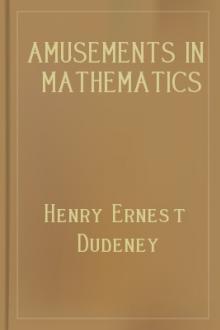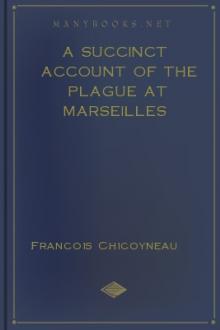Amusements in Mathematics, Henry Ernest Dudeney [books to read to be successful txt] 📗

- Author: Henry Ernest Dudeney
- Performer: 0486204731
Book online «Amusements in Mathematics, Henry Ernest Dudeney [books to read to be successful txt] 📗». Author Henry Ernest Dudeney
Owing to the fact that no number of five figures can have a digital sum less than 15 or more than 35, we find that the figures of our product must sum to either 18 or 27 to produce the root 9, and to either 22 or 31 to produce the root 4. There are 3 ways of selecting five different figures that add up to 18, there are 11 ways of selecting five figures that add up to 27, there are 9 ways of selecting five figures that add up to 22, and 5 ways of selecting five figures that add up to 31. There are, therefore, 28 different groups, and no more, from any one of which a product may be formed.
We next write out in a column these 28 sets of five figures, and proceed to tabulate the possible factors, or multipliers, into which they may be split. Roughly speaking, there would now appear to be about 2,000 possible cases to be tried, instead of the 30,240 mentioned above; but the process of elimination now begins, and if the reader has a quick eye and a clear head he can rapidly dispose of the large bulk of these cases, and there will be comparatively few test multiplications necessary. It would take far too much space to explain my own method in detail, but I will take the first set of figures in my table and show how easily it is done by the aid of little tricks and dodges that should occur to everybody as he goes along.
My first product group of five figures is 84,321. Here, as we have seen, the root of each factor must be 3 or a multiple of 3. As there is no 6 or 9, the only single multiplier is 3. Now, the remaining four figures can be arranged in 24 different ways, but there is no need to make 24 multiplications. We see at a glance that, in order to get a five-figure product, either the 8 or the 4 must be the first figure to the left. But unless the 2 is preceded on the right by the 8, it will produce when multiplied either a 6 or a 7, which must not occur. We are, therefore, reduced at once to the two cases, 3 × 4,128 and 3 × 4,281, both of which give correct solutions. Suppose next that we are trying the two-figure factor, 21. Here we see that if the number to be multiplied is under 500 the product will either have only four figures or begin with 10. Therefore we have only to examine the cases 21 × 843 and 21 × 834. But we know that the first figure will be repeated, and that the second figure will be twice the first figure added to the second. Consequently, as twice 3 added to 4 produces a nought in our product, the first case is at once rejected. It only remains to try the remaining case by multiplication, when we find it does not give a correct answer. If we are next trying the factor 12, we see at the start that neither the 8 nor the 3 can be in the units place, because they would produce a 6, and so on. A sharp eye and an alert judgment will enable us thus to run through our table in a much shorter time than would be expected. The process took me a little more than three hours.
I have not attempted to enumerate the solutions in the cases of six, seven, eight, and nine digits, but I have recorded nearly fifty examples with nine digits alone.
86.—QUEER MULTIPLICATION.—solution
If we multiply 32547891 by 6, we get the product, 195287346. In both cases all the nine digits are used once and once only.
87.—THE NUMBER CHECKS PUZZLE.—solution
Divide the ten checks into the following three groups: 7 1 5—4 6—3 2 8 9 0, and the first multiplied by the second produces the third.
88.—DIGITAL DIVISION.—solution
It is convenient to consider the digits as arranged to form fractions of the respective values, one-half, one-third, one-fourth, one-fifth, one-sixth, one-seventh, one-eighth, and one-ninth. I will first give the eight answers, as follows:—
The sum of the numerator digits and the denominator digits will, of course, always be 45, and the "digital root" is 9. Now, if we separate the nine digits into any two groups, the sum of the two digital roots will always be 9. In fact, the two digital roots must be either 9—9, 8—1, 7—2, 6—3, or 5—4. In the first case the actual sum is 18, but then the digital root of this number is itself 9. The solutions in the cases of one-third, one-fourth, one-sixth, one-seventh, and one-ninth must be of the form 9—9; that is to say, the digital roots of both numerator and denominator will be 9. In the cases of one-half and one-fifth, however, the digital roots are 6—3, but of course the higher root may occur either in the numerator or in the denominator; thus 2697/13485, 2769/13845, 2973/14865, 3729/18645, where, in the first two arrangements, the roots of the numerator and denominator are respectively 6—3, and in the last two 3—6. The most curious case of all is, perhaps, one-eighth, for here the digital roots may be of any one of the five forms given above.
The denominators of the fractions being regarded as the numerators multiplied by 2, 3, 4, 5, 6, 7, 8, and 9 respectively, we must pay attention to the "carryings over." In order to get five figures in the product there will, of course, always be a carry-over after multiplying the last figure to the left, and in every case higher than 4 we must carry over at least three times. Consequently in cases from one-fifth to one-ninth we cannot produce different solutions by a mere change of position of pairs of figures, as, for example, we may with 5832/17496 and 5823/17469, where the 2/6 and 3/9 change places. It is true that the same figures may often be differently arranged, as shown in the two pairs of values for one-fifth that I have given in the last paragraph, but here it will be found there is a general readjustment of figures and not a simple changing of the positions of pairs. There are other little points that would occur to every solver—such as that the figure 5 cannot ever appear to the extreme right of the numerator, as this would result in our getting either a nought or a second 5 in the denominator. Similarly 1 cannot ever appear in the same position, nor 6 in the fraction one-sixth, nor an even figure in the fraction one-fifth, and so on. The preliminary consideration of such points as I have touched upon will not only prevent our wasting a lot of time in trying to produce impossible forms, but will lead us more or less directly to the desired solutions.
89.—ADDING THE DIGITS.—solution
The smallest possible sum of money is £1, 8s. 9¾d., the digits of which add to 25.
90.—THE CENTURY PUZZLE.—solution
The problem of expressing the number 100 as a mixed number or fraction, using all the nine digits once, and once only, has, like all these digital puzzles, a fascinating side to it. The merest tyro can by patient trial obtain correct results, and there is a singular pleasure in discovering and recording each new arrangement akin to the delight of the botanist in finding some long-sought plant. It is simply a matter of arranging those nine figures correctly, and yet with the thousands of possible combinations that confront us the task is not so easy as might at first appear, if we are to get a considerable number of results. Here are eleven answers, including the one I gave as a specimen:—
Now, as all the fractions necessarily represent whole numbers, it will be convenient to deal with them in the following form: 96 + 4, 94 + 6, 91 + 9, 82 + 18, 81 + 19, and 3 + 97.
With any whole number the digital roots of the fraction that brings it up to 100 will always be of one particular form. Thus, in the case of 96 + 4, one can say at once that if any answers are obtainable, then the roots of both the numerator and the denominator of the fraction will be 6. Examine the first three arrangements given above, and you will find that this is so. In the case of 94 + 6 the roots of the numerator and denominator will be respectively 3—2, in the case of 91 + 9 and of 82 + 18 they will be 9—8, in the case of 81 + 19 they will be 9—9, and in the case of 3 + 97 they will be 3—3. Every fraction that can be employed has, therefore, its particular digital root form, and you are only wasting your time in unconsciously attempting to break through this law.
Every reader will have perceived that certain whole numbers are evidently impossible. Thus, if there is a 5 in the whole number, there will also be a nought or a second 5 in the fraction, which are barred by the conditions. Then multiples of 10, such as 90 and 80, cannot of course occur, nor can the whole number conclude with a 9, like 89 and 79, because the fraction, equal to 11 or 21, will have 1 in the last place, and will therefore repeat a figure. Whole numbers that repeat a figure, such as 88 and 77, are also clearly useless. These cases, as I have said, are all obvious to every reader. But when I declare that such combinations as 98 + 2, 92 + 8, 86 + 14, 83 + 17, 74 + 26, etc., etc., are to be at once dismissed as impossible, the reason is not so evident, and I unfortunately cannot spare space to explain it.
But when all those combinations have been struck out that are known to be impossible, it does not follow that all the remaining "possible forms" will actually work. The elemental form may be right enough, but there are other and deeper considerations that creep in to defeat our attempts. For example, 98 + 2 is an impossible combination, because we are able to say at once that there is no possible form for the digital roots of the fraction equal to 2. But in the case of 97 + 3 there is a possible form for the digital roots of the fraction, namely, 6—5, and it is only on further investigation that we are able to determine that this form cannot in practice be obtained, owing to curious considerations. The working is greatly simplified by a process of elimination, based on such considerations as that certain multiplications produce a repetition of figures, and that the whole number cannot be from 12 to 23 inclusive, since in every such case sufficiently





Comments (0)